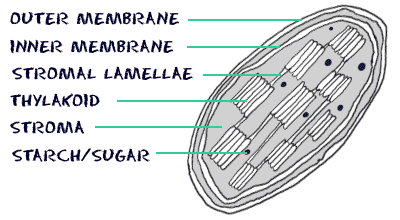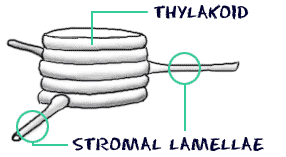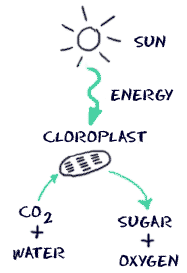 Chloroplasts are the food producers of the cell. The organelles are only found inplant cells and some protistssuch as algae. Animal cells do not have chloroplasts. Chloroplasts work to convert light energy of the Sun into sugars that can be used by cells. The entire process is called photosynthesis and it all depends on the little green chlorophyll molecules in each chloroplast.
Chloroplasts are the food producers of the cell. The organelles are only found inplant cells and some protistssuch as algae. Animal cells do not have chloroplasts. Chloroplasts work to convert light energy of the Sun into sugars that can be used by cells. The entire process is called photosynthesis and it all depends on the little green chlorophyll molecules in each chloroplast. Plants are the basis of all life on Earth. They are classified as the producers of the world. In the process of photosynthesis, plants create sugars and release oxygen (O2). The oxygen released by the chloroplasts is the same oxygen you breathe every day. Mitochondria work in the opposite direction. They use oxygen in the process of releasing chemical energy from sugars.
Special Structures
 We'll hit the high points for the structure of a chloroplast. Two membranes contain and protect the inner parts of the chloroplast. They are appropriately named the outer and inner membranes. The inner membrane surrounds the stroma and the grana (stacks ofthylakoids). One thylakoid stack is called a granum.
We'll hit the high points for the structure of a chloroplast. Two membranes contain and protect the inner parts of the chloroplast. They are appropriately named the outer and inner membranes. The inner membrane surrounds the stroma and the grana (stacks ofthylakoids). One thylakoid stack is called a granum. Chlorophyll molecules sit on the surface of each thylakoid and capture light energy from the Sun. As energy rich molecules are created by the light-dependent reactions, they move to the stroma where carbon (C) can be fixed and sugars are synthesized.
The stacks of thylakoid sacs are connected by stroma lamellae. The lamellae act like the skeleton of the chloroplast, keeping all of the sacs a safe distance from each other and maximizing the efficiency of the organelle. If all of the thylakoids were overlapping and bunched together, there would not be an efficient way to capture the Sun’s energy.
Making Food
 The purpose of the chloroplast is to make sugars that feed the cell’s machinery. Photosynthesisis the process of a plant taking energy from the Sun and creating sugars. When the energy from the Sun hits a chloroplast and the chlorophyll molecules, light energy is converted into the chemical energy found in compounds such asATP and NADPH.
The purpose of the chloroplast is to make sugars that feed the cell’s machinery. Photosynthesisis the process of a plant taking energy from the Sun and creating sugars. When the energy from the Sun hits a chloroplast and the chlorophyll molecules, light energy is converted into the chemical energy found in compounds such asATP and NADPH. Those energy-rich compounds move into the stroma where enzymes fix the carbon atoms from carbon dioxide (CO2). The molecular reactions eventually create sugar and oxygen (O2). Plants and animals then use the sugars (glucose) for food and energy. Animals also breathe the oxygen gas that is released.
Different Chlorophyll Molecules
Not all chlorophyll is the same. Several types of chlorophyll can be involved in photosynthesis. You will hear about chlorophyll a and b most often. All chlorophylls are varieties of green and have a common chemical structure called a porphyrin ring.There are other molecules that are also photosynthetic. One day you might hear about carotenoids in carrots, phycocyanin in bacteria,phycoerythrin in algae, or fucoxanthin in brown algae. While these compounds might be involved in photosynthesis, they are not all green or the same structure as chlorophyll. Accessory pigments such as carotenoids and fucoxanthin pass absorbed light energy to neighboring chlorophyll molecules instead of using it themselves.








0 comments:
Post a Comment